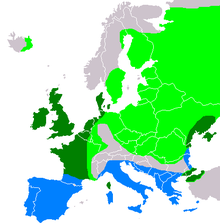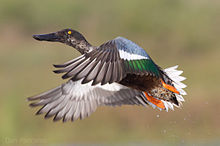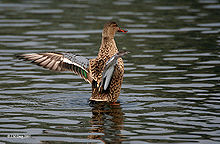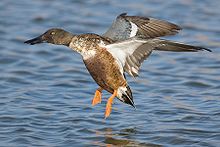- Northern Shoveler
-
Northern Shoveler 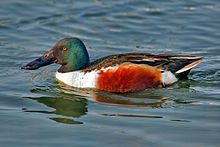
Male 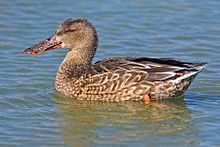
Female Conservation status Scientific classification Kingdom: Animalia Phylum: Chordata Class: Aves Order: Anseriformes Family: Anatidae Subfamily: Anatinae Genus: Anas (disputed) Species: A. clypeata Binomial name Anas clypeata
Linnaeus, 1758European distribution. Light green: summer only. Blue: winter only. Dark green: all-year. Synonyms Spatula clypeata (but see text)
The Northern Shoveler (
 /ˈʃʌvələr/; Anas clypeata), Northern Shoveller in British English, sometimes known simply as the Shoveler, is a common and widespread duck. It breeds in northern areas of Europe and Asia and across most of North America,[2] and is a rare vagrant to Australia. In North America, it breeds along the southern edge of Hudson Bay and west of this body of water, and as far south as the Great Lakes west to Colorado, Nevada, and Oregon.[3][4]
/ˈʃʌvələr/; Anas clypeata), Northern Shoveller in British English, sometimes known simply as the Shoveler, is a common and widespread duck. It breeds in northern areas of Europe and Asia and across most of North America,[2] and is a rare vagrant to Australia. In North America, it breeds along the southern edge of Hudson Bay and west of this body of water, and as far south as the Great Lakes west to Colorado, Nevada, and Oregon.[3][4]The Northern Shoveler is sometimes referred to by hunters as the "spoony". Other disparaging names, as compared to the mallard, are the "smiling mallard" and the "Poor Man's Mallard".[5]
The Northern Shoveler is one of the species to which the Agreement on the Conservation of African-Eurasian Migratory Waterbirds (AEWA) applies.[6] The conservation status of this bird is Least Concern.[1]
Contents
Taxonomy
This species was described by Linnaeus in his Systema naturae in 1758 under its current scientific name.[7] Usually placed in Anas like most dabbling ducks, it stands well apart from such species as the Mallard and together with the other shovelers and their relatives forms a "blue-winged" group that may warrant separation as genus Spatula.
No living subspecies are accepted today. Fossil bones of a very similar duck have been found in Early Pleistocene deposits at Dursunlu (Turkey). It is unresolved, however, how these birds were related to the Northern Shoveler of today; i.e., whether the differences noted were due to being a related species or paleosubspecies, or attributable to individual variation.[8]
Description
This species is unmistakable in the northern hemisphere due to its large spatulate bill. The breeding drake has an iridescent dark green head,[5] white breast and chestnut belly and flanks. In flight, pale blue forewing feathers are revealed, separated from the green speculum by a white border. In early fall the male will have a white crescent on each side of the face.[4] In non-breeding (eclipse) plumage, the drake resembles the female.
The female is a drab mottled brown like other dabblers,[5] with plumage much like a female Mallard, but easily distinguished by the long broad bill, which is gray tinged with orange on cutting edge and lower mandible.[4] The female's forewing is grey.
They are 19 inches long (48 cm) and have a wingspan of 30 inches (76 cm) with a weight of 1.3 pounds (600 g).[3]
Behaviour
Northern Shovelers feed by dabbling for plant food, often by swinging its bill from side to side and using the bill to strain food from the water. They use their highly specialized bill (from which their name is derived) to forage for aquatic invertebrates - a carnivorous diet. Their wide-flat bill is equipped with well-developed lamellae - small, comb-like structures on the edge of the bill that act like sieves, allowing the birds to skim crustaceans and plankton from the water's surface. This adaptation, more specialized in shovelers, gives them an advantage over other puddle ducks, with which they do not have to compete for food resources during most of the year. Thus, mud-bottomed marshes rich in invertebrate life are their habitat of choices.[5]
The shoveler prefers to nest in grassy areas away from open water. Their nest is a shallow depression on the ground, lined with plant material and down. Hens typically lay about nine eggs. The drakes are very territorial during breeding season and will defend their territory and partners from competing males. Drakes also engage in elaborate courtship behaviors, both on the water and in the air; it is not uncommon for a dozen or more males to pursue a single hen. Despite their stout appearance, shovelers are nimble fliers.[5]
This is a fairly quiet species. The male has a clunking call, whereas the female has a Mallard-like quack.
Habitat and range
This is a bird of open wetlands, such as wet grassland or marshes with some emergent vegetation.
This bird winters in southern Europe, Africa, northern South America, and the Malay Archipelago.[2] In North America it winters south of a line from Washington to Idaho and from New Mexico east to Kentucky, also along the Eastern Seaboard as far north as Massachusetts.[3][4] In the British Isles, home to more than 20% of the North Western European population, it is best known as a winter visitor, although it is more frequently seen in southern and eastern England, especially around the Ouse Washes, the Humber and the North Kent Marshes, and in much smaller numbers in Scotland and western parts of England. In winter, breeding birds move south, and are replaced by an influx of continental birds from further north. It breeds across most of Ireland, but in very small numbers.
This dabbling duck is strongly migratory and winters further south than its breeding range (so far so that there have been four reports in Australia).[citation needed] It is not as gregarious as some dabbling ducks outside the breeding season and tends to form only small flocks. Among North America's duck species, northern shovelers trail only mallards and blue-winged teal in overall abundance. Their populations have been healthy since the 1960s, and have soared in recent years to more than 4 million birds (2011), most likely because of favorable breeding, migration, and wintering habitat conditions.[5]
Footnotes
References
- AEWA "Annex 2: Waterbird species to which the Agreement applies". Agreement on the conservation of African-Eurasian migratory Waterbirds (AEWA). AEWA. http://www.unep-aewa.org/documents/agreement_text/eng/pdf/aewa_agreement_text_annex2.pdf. Retrieved 2008-01-13.
- Clements, James, (2007) The Clements Checklist of the Birds of the World, Cornell University Press, Ithaca
- Dunn, J. & Alderfer, J. (2006) National Geographic Field Guide to the Birds of North America 5th Ed.
- Floyd, T (2008) Smithsonian Field Guide to the Birds of North America Harper Collins, NY
- IUCN (2009) BirdLife International Anas clypeata Downloaded on 08 Jan 2009
- Linnaeus, C (1758). Systema naturae per regna tria naturae, secundum classes, ordines, genera, species, cum characteribus, differentiis, synonymis, locis. Tomus I. Editio decima, reformata. Holmiae. (Laurentii Salvii). pp. 124. "A. macula alarum rufa nigra alba." (Latin)
- Louchart, Antoine; Mourer-Chauviré, Cécile; Guleç, Erksin; Howell, Francis Clark & White, Tim D. (1998): L'avifaune de Dursunlu, Turquie, Pléistocène inférieur: climat, environnement et biogéographie. C. R. Acad. Sci. Paris IIA 327(5): 341-346.doi:10.1016/S1251-8050(98)80053-0(French)
External links
- RSPB A to Z of UK Birds[dead link]
- Northern Shoveler Information and Photos at South Dakota Birds and Birding
- Northern Shoveler Information at Cornell Lab of Ornithology
- Northern Shoveler at USGS Patuxent Bird Identification InfoCenter
- Massachusetts Breeding Bird Atlas
- Northern Shoveler videos, photos & sounds on the Internet Bird Collection
- Northern Shoveler on the Birds of India
Categories:- IUCN Red List least concern species
- Birds of Western Australia
- Ducks
- Anas
- Birds of Europe
- Birds of Iceland
- Birds of India
- Birds of Turkey
- Birds of Pakistan
- Birds of Iran
- Birds of Japan
- Birds of Australia
- Birds of the United States
- British Isles coastal fauna
Wikimedia Foundation. 2010.


